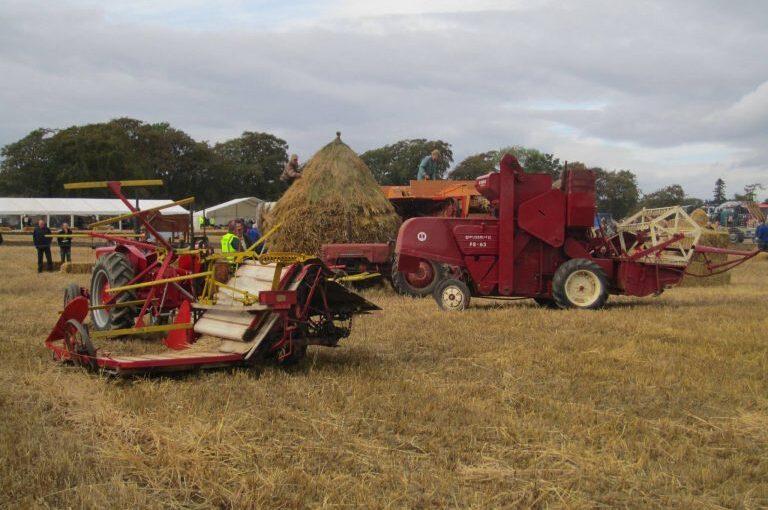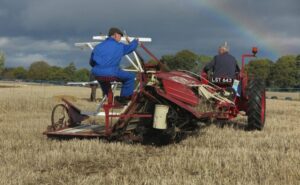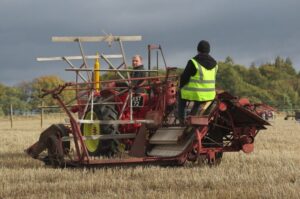The early 1930s was an important period in farm mechanisation in Scotland (and throughout Britain). One of the key developments was in the adoption of the combine harvester. In Scotland the newspapers carried a number of articles on this new machine, and views on whether it could or would be successfully adopted by farmers.
The following are some articles that report the early days of the combine harvester and other technologies at this time:
From the Midlothian advertiser, 4 March 1932
“The combine harvester
Cuts Canadian labour requirements
The introduction of the combine harvester has been an important factor in reducing demand for labour for the farms on the Canadian praries. By the earlier system of harvesting by means of the self-binder, still extensively used, the best efforts of a labourer in the harvest fields did not accomplish as much in the way of harvesting as his same efforts would accomplish in the spring in the planting of the crop. In other words, it required about two men in the autumn to harvest the crop which could be planted by one man in the spring.
Labour saving is effected due to the fact that all the harvest work is combined in one operation. By the self-binder method the grain must be cut, the sheaves must be set up in stooks to dry, the stooks must be loaded on to the waggon and hauled to the threshing mill, and there the threshing must be done. The combine harvester combines all these operations into one, cutting the wheat and threshing it as rapidly as it can be moved over the field. All the labour of stooking, for which the harvest hands were particularly required, is eliminated. The cost of binder twine, also a considerable factor in wheat farm expenses, is saved.
Notwithstanding these advantages, however, there is little reason to believe that the combine will entirely displace the self-binder. On account of their cost, combines, to be used economically, must be operated on large farms or groups of farms.”
From The Scotsman, 13 January 1933
“The combine harvester
The combine harvester cuts the heads of wheat, leaving the straw standing, it carries the heads into a threshing drum, threshes, winnows, and bags the grain; it weighs the bags, and they are them removed ready for dispatch to the railway siding. Machines are made to cut a 10 to 15 foot swathe, and with their aid two men can complete the harvesting of 50 acres of wheat per day. Grains need not be man-handles at all from the field right through to the bakehouse. For the most effective use of the combine harvester, the standing crop must be completely ripe and sufficiently dry to allow the wheat to be bagged within a minute of its being cut; moreover, the machine is only economical in use where large areas of wheat are harvested. These factors impose limitations upon the world-wide adoption of the combine harvester, but modifications in the size of the outfit, the adoption of methods of artificially drying the grain, and the breeding of wheats which can stand long enough to reach complete maturity, are extending its use to areas of moderate-sized farms and to moister climates. Combine harvesters have successfully harvested English crops under favourable weather conditions. Adaptations to local conditions will probably be made. Nevertheless, the general use of the combine harvester in its most economic form is at present limited to the West and Middle West of the United States of America, Argentina, Australia, parts of Canada, and the drier districts of Russia, such as the Northern Caucasus. Probably in Hungry climatic conditions are also favourable, and the same is true of most of Italy.”
From the Dundee evening telegraph, 27 July 1934
“Robots are coming to our farms
Mechanisation is rapidly invading every sphere of agriculture.
Indeed, just as the present era of engineer-farming supplanted that of the old-fashioned primitive hand cultivation, the former is being ousted by what has been aptly named “robot-farming”.
A striking example of this is to be seen in Norfolk. There, on one farm of many hundreds of acres, hedges have been removed and small fields thrown into large ones, and not a single animal is seen, every operation being carried out by machinery.
Evidence of the coming change can be seen at all large agricultural shows, such as the Royal Show held recently at Ipswich, where some of the most impressive displays show the latest mechanical aids of agriculture side by side with the centuries-old appliances of the village and rural craftsman.
Such, for instance, are the veritable super-ploughs now being built, which may cost as much as £6,000 each, and which are capable of turning an acre of land an hour. Some are of 150 horse-power, and weigh 15 tons.
The combine harvester
In the future there is not the slightest doubt that machinery will be indispensable during the harvest.
A few years ago the combine-harvester was unknown in this country; now it is found in all parts.
This machine cuts and threshes the corn as it works round the field, doing away with the necessity for standing up the corn in shocks, carting and stacking, and at the same time relieves the farmer of the worry of getting his corn wet through before he can get it stacked and thatched.
This season it is expected that at least 10,000 acres will be cut and threshed by combine-harvesters.
Machines of this type are used in Canada and the United States. Eight years ago the Dominion had fewer than 200 of them, but at the present time there are something like 10,000 in use, worth approximately £5,000,000.
Defeating the weather
The hay harvest , or “haysel”, is another operation which frequently gives the farmer considerable worry, especially in Britain, where climate is fickle, and where on occasion whole crops have been ruined by inopportune rain.
For this reason the agricultural engineer has turned his attention to this crop too, and striking advances have been made.
The old method of cutting hay with the horse mower was satisfactory, but tractor mowers work far quicker, and take a wider sweep, so that the hay can be cut when in the best condition, and the haysel finished when the weather is good.
The farmer is also defeating the weather in another way, for electricity has come to his aid in the drying of the crop.
Rain has now little chance of deteriorating the cut where such aids are utilised, for the hay is carted directly after being moved, and a stack is erected over ducting of simple construction. An electric fan forces air through the ducts, and the hay is cured in this manner.
This is only one of the applications of electricity on the modern farm, and it is estimated that 2,000,000 farmers throughout the world have electrified their holdings.”



